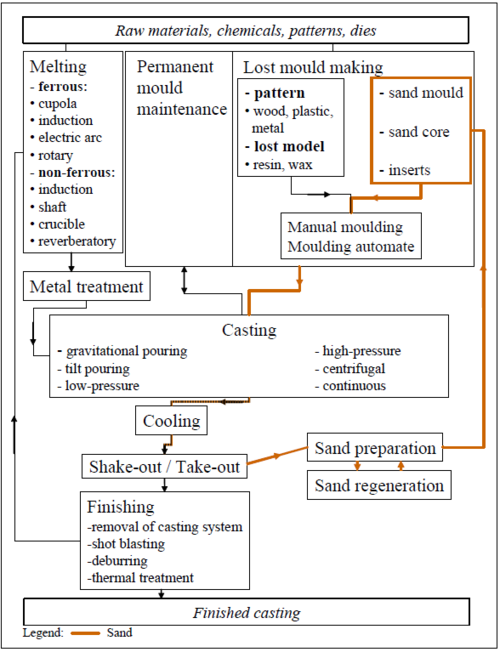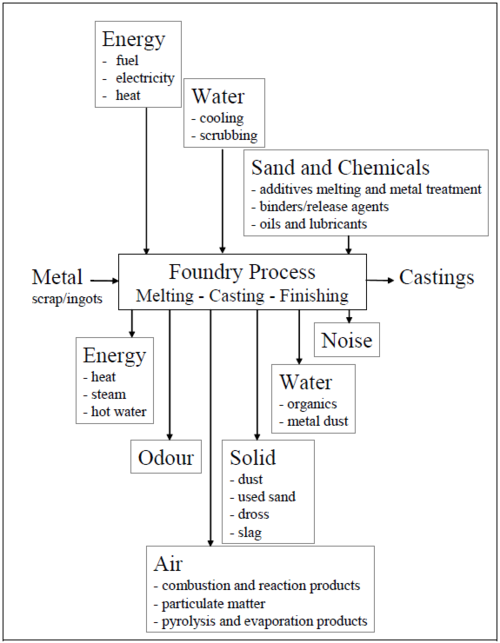Founding in metal industry
Back to Subsection DC metals
General description
The process can bedivided into the following major activities:
- melting and metal treatment: the melting shop
- preparation of moulds: the moulding shop
- casting of the molten metal into the mould, cooling for solidification and removing the
casting from the mould: the casting shop
- finishing of the raw casting: the finishing shop.
Figure 1: The foundry process
Starting from foundry scrap (selected scrap according to a certain chemical composition) or
ingots, the foundry produces finished castings. Usually these are components which will require
further treatment or assembly to yield a final product.
On the moulding side, a basic distinction is made between permanent and lost moulds.
Foundries casting in permanent moulds, buy these metal moulds (dies) externally, but typically
operate an in-house mould repair and maintenance shop. Foundries casting in lost moulds, often
buy wooden, metal or plastic patterns (for their mould design) and operate an in-house pattern
maintenance and repair shop. Moulds, cores and lost models are generally produced as part of
the foundry process.
Traditionally in the foundry sector the main distinction made is between ferrous and non-ferrous foundries. This is mainly because the applied processes in both sectors differ. Non-ferrous foundries often apply die-casting techniques. These allow a better surface finish, which is important for many of the aluminium and brass applications. Due to the high cooling rate, castings with a high mechanical strength are produced. However, this technique does not allow the production of massive or large pieces, which require sand casting techniques. Sand casting techniques are applied in non-ferrous foundries for those products that are not produced in large series. The non-ferrous metals (and their alloys) discussed in this document are:
- aluminium
- magnesium
- copper
- zinc
- lead.
Ferrous foundries generally apply the lost mould techniques. Due to their greater stiffness and strength, ferrous alloys are used in different applications to non-ferrous alloys. The size of the products that can be produced is almost unlimited. Ferrous metals have a higher melting point and therefore require different melting techniques. The ferrous metals and alloys discussed in this document are the various types of cast iron (which may be classified according to their properties or by the graphite type) and cast steel.
Superalloys with a high content of alloying elements, such as nickel, will also be discussed. Foundries utilise mechanisation and automation depending on the need for reproductivity and on the series sizes. The most flexible installation is typically the jobbing foundry. This produces a variety of products in small numbers (<100). In general, this type of foundry applies manual moulding techniques with resin-bonded sand moulds. The melting furnace works batch wise to allow an easy change of alloy. This implies the use of induction or rotary furnaces. For medium-sized series (<1000 parts), mechanised moulding and casting lines are used. Lost mould foundries utilise mould making machines. This implies the use of green sand, which allows fast mould making. The size of the mould making machine limits the maximum size of the castings. Casting can be performed manually or by using a pouring machine. Auxiliary side processes, such as sand preparation, are operated in a semi-automated way with remote control. Both continuous furnaces (cupola, shaft) and batch furnaces are used. For non-ferrous alloys, die-casting techniques are applied.
Large series of small castings are made in flaskless green sand moulding. For specific applications, die-casting also can be used in ferrous foundries if the final casting quality requires it, although in reality the technique finds only limited implementation. The main difference for medium-sized series is the further automation of the finishing, the quality control and the mould assembly. For die-casting in non-ferrous alloy facilities, further automation is often applied, this is especially the case in pressure die-casting shops.
Specific casting techniques, such as full mould casting, centrifugal casting and continuous casting are applied where the product type requires it.
Mass stream overview for the foundry process
Coke and energy consumption
In cold blast operation, the coke consumption between the charges is generally 90 - 120 kg/tonne metal charge, but can be less than 70 kg/tonne metal charge, e.g. in the case of counterweights. Accounting for the amount of coke in the bed gives a total coke consumption of 110 – 140 kg/tonne metal charge. As the calorific value of European cokes is 8.5 kWh/kg, this corresponds to a calorific input of 950 – 1200 kWh/tonne metal charge.
The total coke ratio in a hot blast cupola is generally 110 – 145 kg/tonne metal charge. However, as the average steel percentage is 50 %, and the recarburisation consumes about 1.5 %, the real burned coke ratio is 95 – 130 kg/tonne metal charge, which is 810 to 1100 kWh/tonne metal charge. This corresponds to a thermal efficiency of 35 to 45 %.
Depending on the plant layout, the energy consumed by the fume treatment equipment and the holding furnace, as given in Table 3.2, must be added. German data indicate a specific electricity use for the flue-gas cleaning equipment of c. 20 kWh per tonne of good casting. [202, TWG, 2002]
Table 1: Average energy consumption for off-gas treatment and holding
Source: European Commission, Reference Document on Best Available Techniques in the Smitheries and Foundries Industry, May 2005, p.13-14, 97
Back to Subsection DC metals


